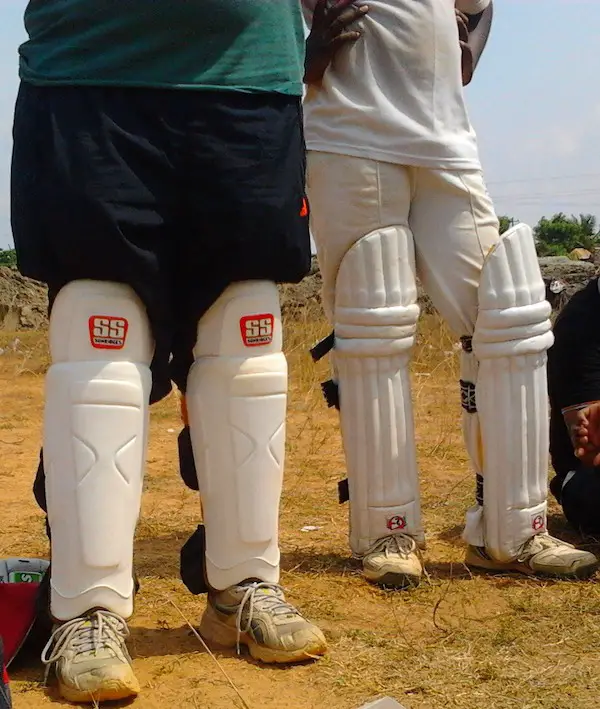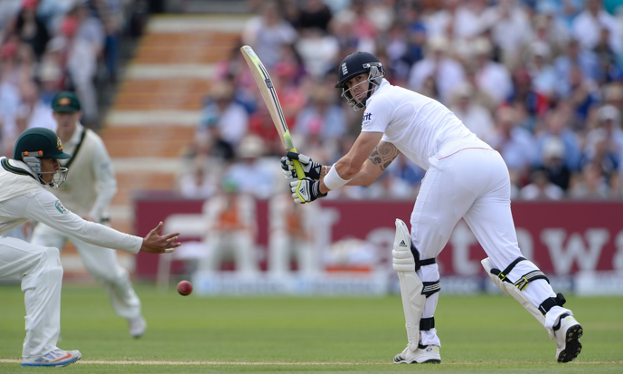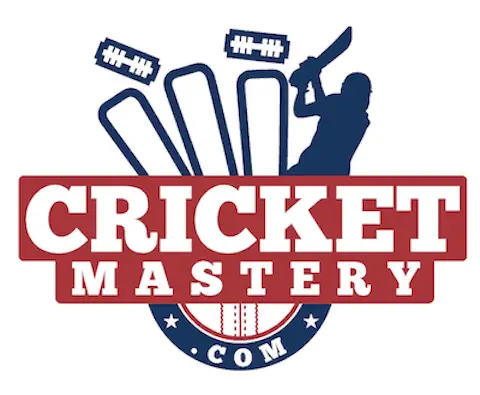Nobody likes getting hit in the leg with a cricket ball – especially when you’re a batsman! However, when this does happen, at least you can be thankful that your pads have made this experience less physically painful. But, how exactly do cricket pads protect you? What is it exactly made of?
Cricket pads are made from cane, leather and cotton traditionally. These “Cane Pads” have a leather coating which is stuffed with cotton and sticks of cane. The more modern cricket pads are made from “High Density Foam” which make the cricket pads safe, light and comfortable to wear.
The materials which pads are made from are important to understand, but it’s also important to know how it is best to wear them and what to look out for when you are buying your own.
Why are Cricket Pads Required?

Every batsman must be wearing pads to cover the front of his or her legs when they go out to bat. You might often find that batsmen also wear a number of other pads around different parts of their bodies, especially if they bat lower down the order and are less confident in their batting ability.
If you know you’re prone to missing the ball and getting hit, it’s wise to avoid getting nasty bruises that might hinder your bowling performance later.
There are also occasions when the fielding team will wear pads. The prime example of this is the wicket keeper, who must wear pads to cover his shins and knee – much like those worn by batsmen.
Wicketkeeper pads are, however, smaller than batting pads to allow for greater mobility and so that it is less likely for a ball to get trapped between the knee roll and the thigh – in which case a batsman could quite, unfortunately, be given out.
Those players fielding close to the batsman, in positions with the pre-fix ‘silly’ (such as silly point or silly mid-off) might also wear discreet padding to cover their shins and or chest.
The History of Cricket Pads

While the game of cricket is thought to have originated in the 1500s, batting pads only first began to be used in the mid-1700s. This was coincidentally (or possibly even in relation to the fact that) cricket balls began to be made using the design we see now, with hard-leather exteriors wrapped around a cork core. Even in those hardy times, people didn’t fancy taking a cricket ball to the shin.
What’s more, it wasn’t long after pads were introduced that the LBW rule was first brought into action. Lawmakers had obviously needed to find a way to stop batsmen purposefully using their now protected legs to prevent the ball from hitting the stumps. It is important to remember that it would have been much easier to block the ball with your legs at this time since overarm bowling wasn’t legalised until the 1860s.
During the 19th and early 20th centuries, the cricket pads were designed without the same level of cotton padding you often see today. These pads were known as skeleton pads and the cane formed a grill around the shin, much more like that which you see on a cricket helmet today than you would a pad.

The exterior shell of a cane pad is traditionally made of leather on the outward facing part and a softer fabric on the inside. In many cases, these are still hand stitched around the world.
The leather has often been painted or dyed white traditionally, although, with the increasingly varied colours worn by modern-day cricket teams, they can now come with ‘wraps’ of pretty much any colour you desire.
What are Modern Day Cricket Pads made of?

For the majority of the history of the game, the method of making Cane Pads has been dominant in the production of protective equipment. It is an effective form of protection and one that has stood the test of time. As a result, not a lot has evolved over time in the way cricket pads are made.
This method has traditionally relied on a number of wooden cane sticks being inserted into the shell of a pad. This is then stuffed with cotton to add extra protection and create a cushioned feel.
1. Modern Cane Pads

The modern cane pads are just a slight evolution of their traditional predecessors in that the cane skeleton is not visible any more, and they feel more robust.
Batting pads, today, are designed to protect the batsman’s shins, ankle, and knee, and they are attached to the leg by straps which wrap around the batsman’s calf. Ideally, when choosing which pads to buy, the knee roll should rest comfortably against your knee.
2. High Density Foam Pads
The other type of modern cricket pads that are now available are known as the High-Density Foam Pads. While the High-Density Foam (HDF) Pads still maintain the general shape and size of a traditional cane pad, in some cases the materials that they are made from differ to a large extent.
High-Density Foam is used for a number of reasons, however, the most significant of these for many batsmen is the simple matter that it is lighter than the traditional cane and cotton interior explained earlier.

This comes in handy not only when running between the wickets, but also when it comes to carting your kit to and from netting sessions or matches. Economy of weight and size is a consideration that comes into the decision-making process of any cricketer. Especially when it comes to buying any piece of batting equipment.
Another aspect of High-Density Foam Pads that makes them more comfortable than their traditional counterparts is the fact that they can be molded more accurately to the shape of your leg. After all, memory foam mattresses are made from the same stuff!
Top Brands for Cricket Pads
When it comes to Cricket Pads, the proverb “Better Safe than Sorry” literally holds true!
It is not just important to invest in cricket pads, it is important to invest in good quality cricket pads ideally made from reputable brands so that it provides you the safety that you expect from cricket pads!
Fortunately, there are a few good brands available in the market that offer particularly good value for money – especially with regards to pads. I’m sharing a list with a few links below to their recommended products for your convenience –
| S. No | Cricket Pad Brands | Recommended Product [Links to Amazon] |
| 1 | Grey Nicholls | Grey Nicholls (UK, India) |
| 2 | Kookaburra | Kookaburra (UK, India) |
| 3 | GM | Gunn & Moore 808 (UK, India) |
| 4 | SG | SG Campus (UK, India) |
| 5 | PUMA | PUMA EVO (UK, India) |
While more high-end brands, such as Salix, Newbury, and Masuri, are of great quality, you can opt for brands such as GM or Kookaburra, which are somewhat cheaper but who still maintain a high standard of production. Meanwhile, if you specifically want HDF pads then PUMA has a great range of pads for all kinds of budgets.
Pro-Tip:
If, for some reason, you don’t find any of the products listed above as per your liking, be sure to check out the Best Selling Cricket Pads on Amazon. You will definitely find something that suits your requirement!
What’s more, it is also typically the case that the more HDF that is used in a pad, the more expensive the pad will be. It is a more expensive material than the cane and cotton used to make more traditional pads. However, pads that combine both of these like the GM Mythos 606 [on Amazon] can usually the most expensive.
How to Choose the Right Cricket Pads for You?
Now that you know why you need pads and what they are made from, you’re probably wondering what other elements of their design need to be taken into consideration when you go to buy them.
1. Comfort
You must also take into consideration how comfortable they will be for you to play in. More expensive pads will often have greater padding on the inside, which makes them easier to run in, as well as offering greater protection. After all, it’s probably worth spending a little bit more on good quality pads if it means you’ll be able to bat better and ultimately derive greater enjoyment in playing the game as a result.
It is also worth remembering that cricket pads made with HDF will more often than not be lighter than their cane counterparts. Similarly, if the pads are heavier it may mean that they offer more protection. This is a trade-off that you will definitely have to consider; especially if you are looking at middle-ground prices and don’t have a big enough budget to afford the highest quality gear.
2. Size
While choosing your cricket pads, make sure that you go for the correct size. Cricket pads are available for varying sizes. If you are over 20 years old, you should be choosing the ones in the Men’s size.
Likewise, other common sizes that the cricket pads are available in are for youth and for boys. Be sure to check the right size that you are buying your cricket pads for.
3. Material Used – Safest Material Available
As we have discussed already, the most common types of cricket pads based on the materials used are either Cane Cricket Pads and the High Density Foam (HDF) pads.
Cane pads are the safest between the two and generally provide more protection. However, the cane pads are also heavier usually. Likewise, High Density Foam pads are lighter and more comfortable, but are usually more expensive.
Based on your budget and your preference, you can make a choice to the correct type of pads you would like to go for.
4. Cost
Firstly, cost is always an important factor to consider when buying any new piece of cricket equipment.
As with any other item of cricket kit, the general rule is that the more expensive the item the higher quality it will be, the lighter it will be and the more protective it will be. This applies to pads just as much as it does to anything else.
What is the Correct Way to Wear the Cricket Pads?

Wearing the cricket pads is pretty straight forward. There is no right or left pad in the cricket pads. This means, you can wear the same cricket pad either on the left leg or on the right leg.
However, this does raise a sticky question – when wearing the pads, once you have put the velcro, it could be facing towards the inside or towards the outside.
It is recommended to put the velcro towards the inside of the legs. Furthermore, ensure that you fold the extra velcro so that these are not flailing out at the sides when you are batting.
Having the velcro on the outsides could mean that if the velcro happens to open up and the ball brushes on the pads on its way to the wicket-keeper, you could be given out!
Final Thoughts
Cricket Pads are usually made to two types in the modern day. The Cane Cricket Pads provide the most safety while batting. However, the cricket pads made from High Density Foam are also fairly safe, but they provide an additional benefit of being light weight.
It is recommended to purchase the pads the fit the best for you. Wearing the pads before purchasing should be a good way to go.
I hope this post has helped you understand the details of what the pads are made of.

